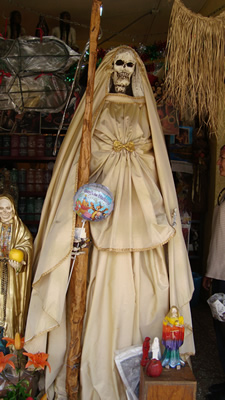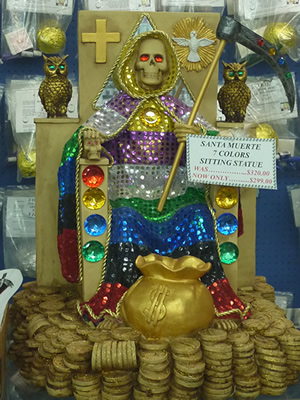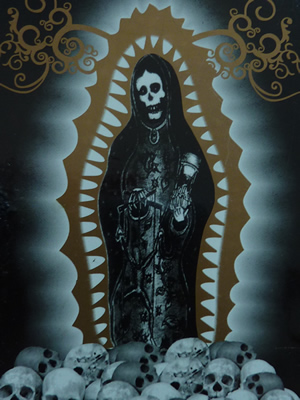Heritage Divide
A UTSA professor's new book explores a religious icon that's revered in Mexico but worshipped only secretly north of the border

Photo courtesy of Malgorzata Oleszkiewicz-Peralba
Is Santa Muerte an evil icon worshipped by narcotraficantes in Mexico and on the border? Or is she the saint of the people who helps those who have nowhere else to turn? As Malgorzata Oleszkiewicz-Peralba explains in her new book, Fierce Feminine Divinities of Eurasia and Latin America, Santa Muerte is both, so much more, and perpetually misunderstood. An associate professor in the department of modern languages and literatures in UTSA's College of Liberal and Fine Arts, Oleszkiewicz-Peralba has been researching worship around the world for decades. In her book, she examines Eastern Europe's Baba Yaga, India's Kali, and Brazil's Pombagira as well as Santa Muerte, popular throughout Mexico and Central America. She talked to Sombrilla Magazine about the myths surrounding Santa Muerte, why she's publicly loved in Mexico but only secretly worshipped in San Antonio, and how the media and law enforcement have given her a bad name.

Photo courtesy of Malgorzata Oleszkiewicz-Peralba
How did you pick your four divinities?
I've been studying for many years ancient and contemporary worship that focuses on divine feminine figures around the world, and I realized that many worship traditions center on feminine divine figures. In this particular case, for the divinities in the book, they have been demonized, sweetened, or dismissed, ridiculed or relegated to children's games and fairy tales. They're all related to the cycle of life, death, sexuality, rage and many other features that have been removed from the official feminine icons like Virgin Mary. This has to do with uncovering submerged truth and empowering women because women have been removed from positions of leadership in all of the main religions as well as from positions of power in politics and in the family.
What do they represent in terms of society?
These deities are marginal, outsider deities, and they are mainly worshipped by people who also feel they are being treated as inferior or marginalized in their respective societies — like people who don't have access to the mainstream privileges, poor people, and people who don't have stable occupations or those being threatened. And of course, women. Because women don't yet have equal position in society. Plus there is a connection to ancient times when Mother Earth was the divinity most worshipped, since she gave life to all living beings. In Mexico the Virgin de Guadalupe has the status of the Queen of the Americas, so they've long prayed to a female saint.
Why has Santa Muerte become such a popular and powerful unofficial saint?
Among the population that Santa Muerte is the most popular with are individuals who are subjected to transitions, transgressions, and instability, like street vendors, migrants, policemen, prisoners, prison guards, and drug traffickers. This devotion spread to the middle class, like social workers and lawyers, anyone who has to deal with very unstable and dangerous circumstances, people dealing daily with death and danger. We know that Mexico has become more dangerous in the past 20 years, and that is why it has become so popular in Mexico. But she is not a new figure. This is a very ancient tradition, and in Mexico there are currently three known Santa Muerte statues that come from the colonial times — the 16th to the 18th century. Also in Spain they have similar images that come from the Middle Ages.

Photo courtesy of Malgorzata Oleszkiewicz-Peralba
People say that she's just, that she treats everyone equally no matter what race, gender, status, or wealth. She's the one who decides whether you are going to live or not. It's a paradox really because they pray to her for good health, for protection, things like that. Before it was more popular to pray to Virgin de Guadalupe, but many interviewees said that Santa Muerte is more powerful because she is not institutionalized. She does not belong to the politicians or the church. She's also rejected. There are things they cannot ask the Virgin de Guadalupe that they can ask Santa Muerte because she is impartial. She's not the only one either, there are many other unofficial saints, but it's interesting to see how popular she's become and how many people are devoted to her. She has millions of followers. They don't want her to be sanctified by the church or the state. The testimonies from followers say nothing else worked but Santa Muerte worked. She has the power.
Why do you think there are so many mischaracterizations of Santa Muerte, especially in media?
It's a manipulation, usually media is very sensationalistic; they want to get viewers. So they try to present this as a taboo topic. And of course with everything there are people who use it for good and for bad. The people who are narco-traffickers, they also need to believe in something, so the one that doesn't reject their activities would be Santa Muerte. There are many other unofficial saints. There's Jesús Malverde with his shrine in Culiacán, Sinaloa; he's a known narcosantón and is widely worshipped by the narcos.
Last year a federal appeals court threw out convictions in a New Mexico drug possession case after ruling the testimony of a San Antonio U.S. marshal neared "psychobabble." The marshal, who regularly trains other law enforcement, testified as an expert witness in Santa Muerte and referred to her as the "narco-saint" and as a tool of the drug trade. What do you think of this characterization and this type of testimony? Does it ever have a place?
This should not be used at all. It's a violation of religious freedoms to use religious identity as proof to criminalize somebody. He would have to arrest millions of people. People need to be more informed. You have to see it in the context of the culture and the tradition. Like I explained, in the Middle Ages and in colonial times she was already worshipped and there is continuity, so they can't say she's new. It's a new manifestation of the same thing that is now stronger and attracting more attention because of increased problems in society. But she should not be identified with crime or criminal activity. To use her as proof of criminal activity is a total aberration. In Mexico she is more out in the open — she has public altars and public masses in the streets, rosaries are performed for her. Here in San Antonio there are no public manifestations of her worship. It's being rejected and criminalized and people don't want to be stigmatized. But almost all botanicas have Santa Muerte products.
Do you think cultural differences prevent understanding of Santa Muerte and also lead to a negative reaction?
There is a continuity between life and death. And in Mexico death is in every level of culture. It's a totally different approach then in the Anglo-Saxon culture. For example, dead people are being placed in a living room for three days so that family and friends can come say goodbye. And that is just a natural passage. After that the bereaved families go to the graves and they eat and play music. They commune with their dead ancestors and that was how it was done pretty much everywhere in the past. But now that practice has been eliminated mostly in Western society. We don't even say "death." We say "he passed away," "he left us," so we use euphemisms to relate to death. Both in ancient and contemporary culture in Latin America, death is not something that should be denied.
Given that it's Hispanic Heritage Month — and what we've discussed is a negative (American) view of Santa Muerte — where does she fit?
We should accept diversity of religion. And the whole idea of a day or a month, it doesn't do it justice. Hispanic heritage exists all year. These labels only provide confusion and divide rather than unite.
